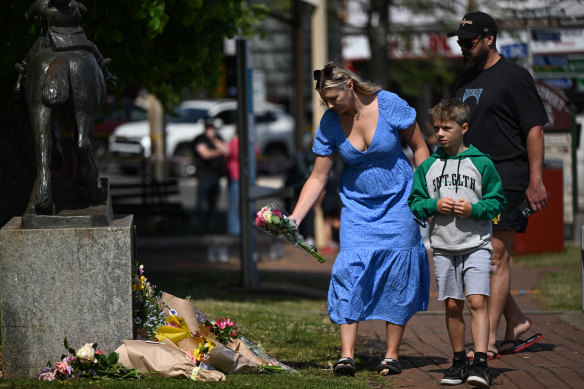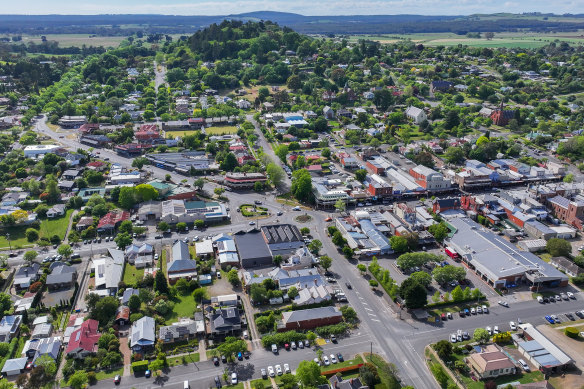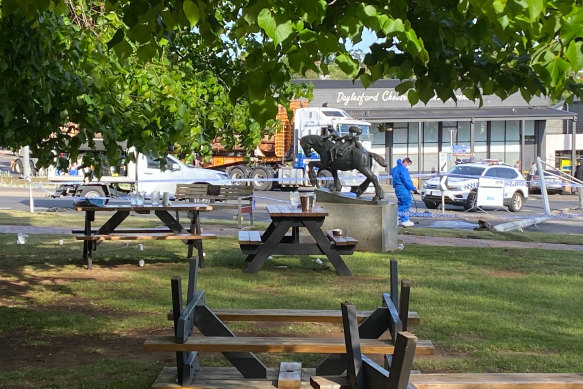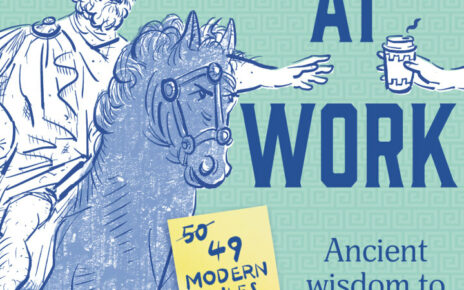Save articles for later
Add articles to your saved list and come back to them any time.
Daylesford hasn’t been so torn by tragedy since 1867, when three boys aged seven, five and four went walking in the Wombat Forest in the middle of winter and perished from cold.
The two youngest huddled together in a hollow tree, the eldest just outside, waiting for rescue that never came.
People lay flowers at a makeshift memorial in Daylesford.Credit: Joe Armao
This is a town that never forgets its calamities.
People still walk to the memorial built for the lost boys in Daylesford’s cemetery and leave a coin, as if something of worth must be done to remember them.
It will be a long time before the memory of what happened 156 years later, on the sunny Sunday afternoon of November 5, 2023, begins to fade in Daylesford.
Such sudden ghastliness is not supposed to happen in full view of tourists and contented townsfolk in such a lovely little town.
An aerial view across Daylesford, including the crash scene near the town’s main roundabout.Credit: Joe Armao
Daylesford is built on hillsides above the old gold diggings that is now the town’s lake.
Like a lot of old gold towns, once filled with roistering sinners and those seeking redemption, it is a place of graceful churches high on the hillside and splendid pubs down in the town, closer to the diggings.
Albert Street – the smaller of two streets with the same name in Daylesford – is one of the lanes that descends from the higher ground, splicing its way between two of those grand old pubs, the Daylesford Hotel and the Royal Daylesford, before finding its way to the town’s main roundabout, where four major streets converge.
Little Albert Street once made a fifth arm of the roundabout, but planners long ago put a dog-leg in it at the bottom of the hill to leave a wide grassy area outside the Royal Daylesford.
The lawn, beneath the deep green foliage of big old elms, is a fine spot for an alfresco pub meal or a beer, children rolling about on the grass, if you ignore the nearby traffic heading through on the Midland Highway or turning up the main street or heading north to Hepburn Springs.
At 6.05pm on Sunday, with a soft evening coming down after that fine spring day, at least two families, adults and children, had set themselves up at the Royal Daylesford’s wooden tables and benches.
And their easy weekend transformed to horror.
There is no explanation yet for why a white BMW SUV, descending the Albert Street slope, failed to negotiate the dog-leg around the pub’s little park and, revving loudly, according to some witnesses, bounced across the lawn, collecting tables, benches and bodies, then careered on, smashing down a light pole and coming to a stop – we cannot call it a rest – on the roundabout beyond.
The scene at a Daylesford beer garden, where a car ploughed into patrons on Sunday.Credit: David Estcourt
The news reports and police statements have given some concept of the carnage and the terror and the anguish of survivors and townsfolk who ran to help.
We need only know what was said by Chief Commissioner of Victoria Police Shane Patton, that the scene was so confronting some of the professionals who responded would be haunted by it. These are people hardened to horror.
Yesterday, there was only imagining left to those who came to the little hotel park, some to lay flowers, some to set up news cameras, some to simply stand and think.
The wreaths of flowers piled up beneath a sculpture of three children on a Clydesdale horse.
From School, the sculpture is called. It is by Stanley Hammond, who attended the Daylesford Technical School in the 1930s.
Could he have had in mind those three children, the lost boys of Daylesford – William and Thomas Graham and Alfred Burman – who never had the pleasure of coming home from school after becoming lost in the Wombat Forest so many years ago?
It seems possible, for the people of Daylesford never forget their tragedies. The local school still offers a scholarship named for the eldest lost boy, William Graham (the Graham Dux award), and now tourists can trek along a 16-kilometre path named the Lost Children’s Walk.
Today, it is too early for memorialising another catastrophe. There is only shock, wreaths by a statue and unanswered questions about the deaths of five people in the centre of one of Australia’s loveliest old towns.
Start the day with a summary of the day’s most important and interesting stories, analysis and insights. Sign up for our Morning Edition newsletter.
Most Viewed in National
From our partners
Source: Read Full Article





